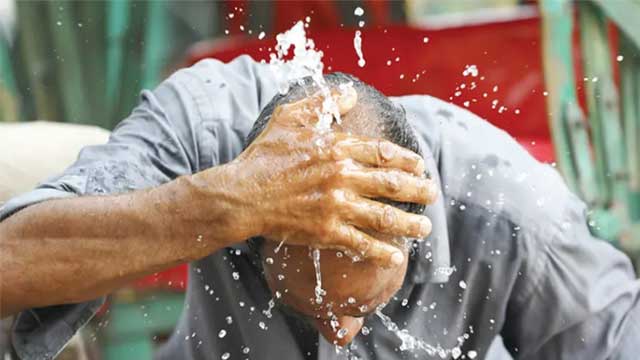The heat wave, persistent over the past week, further intensified on Wednesday as areas affected by the severe heat wave tripled compared with the day before.
A severe heat wave occurs when the day temperature over several weather stations reaches 40C but stays below 42C.
On Wednesday, six districts—Rajshahi, Pabna, Bagerhat, Jashore, Chuadanga and Kushtia—saw their day temperatures reach 40C or go beyond with the country’s maximum temperature of 40.8C recorded in Chuadanga.
Almost entire Khulna division went into the grip of a severe heat wave on Wednesday.
‘The hot weather condition is likely to remain the same for three more days and then further worsen,’ said meteorologist Bazlur Rashid.
Dhaka saw its day temperature rise by more than 2C on Wednesday to 36.3C since a brief spell of rain brought it down to 34C on Tuesday afternoon.
The Bangladesh Meteorological Department predicted isolated shower with squalls at one or two places in Dhaka, Barishal, Chattogram and Sylhet districts today.
The weather in the rest of the country will remain mainly dry with partly cloudy sky, the BMD said, adding that a mild to moderate heat wave was sweeping over Dhaka, Rangpur, Barishal and the rest of the Rajshahi and Khulna divisions.
At 6:00pm Wednesday, the moisture level in the air was recorded to be 87 per cent.
The BMD warned that moisture incursion might increase, intensifying the feeling of heat and discomfort.
The BMD said that westerly and northwesterly continued to blow up to 12kph.
The dominance of westerly and northwesterly explains the rather unusual phenomenon of a severe heat wave sweeping parts of the coastal region for three consecutive days.
On April 15, Barishal’s Khepupara saw its day temperature rise to 40.6C, the highest in 43 years. Chuadanga was being swept by severe heat wave for the second consecutive day.
Continued exposure to excessive heat could result in heat stress which is the loss of human body’s capacity to regulate its internal temperature.
Physicians have advised people to stay indoors between 12:00 noon and 5:00pm and drink two to three litres of water a day.
But everybody cannot follow the advice. In cities and towns hundreds of homeless families live exposed to the scorching heat under the sun.
Heat radiated by metaled roads has made life unbearable for thousands of rickshaw pullers, who spend their day mostly under the open sky, not protected by any shade.
Last year, April 17 was the hottest day when the maximum day temperature recorded to be 43C in Pabna.
Power cuts have made life miserable, especially for farmers who need to irrigate their boro fields by lifting groundwater.
On Wednesday, load shedding peaked at 3:00pm at 582MW with 13,591MW generated against the demand of 14,200MW.
The electricity demand has increased by more than 3,500MW since April 11, the day Eid-ul-Fitr was celebrated amidst general holiday.
Power demand is expected to rise by another 4,000MW by this month. The daytime temperature in the capital is predicted to reach 40C by next week.
Power cuts are likely to rapidly increase as readymade garment factories gradually return to operation full swing within the week.
Last summer, load shedding exceeded 3,000MW.





